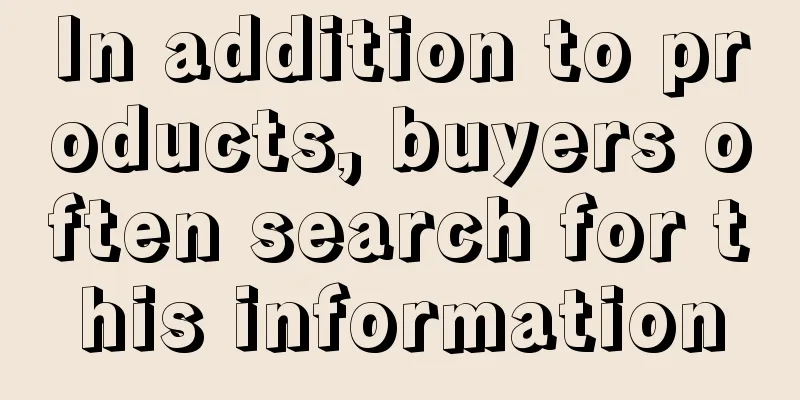In addition to products, buyers often search for this information

|
Years of user experience testing have shown that users search for more than just product names on e-commerce websites. According to user experience testing by research firm Baymard Institute, 34% of users have searched for non-product content (such as return policy, unsubscribe, cancel my order). Whether the user's needs can be met depends on whether the website can provide relevant search results . Baymard Institute's test shows that 15% of e-commerce websites do not support very basic non-product searches, such as "return policy". If this type of search plays a decisive role in the user's purchase but is not resolved, they are likely to abandon the shopping cart. In this article, we discuss findings on non-product search and how buyers conduct non-product search.
Why many users use search to find non-product content Email subscription, return policy and other non-product content are usually in the footer of the website. If the website design is more complex, users may be able to find these contents more easily. A lot of non-product content is hidden in corners that are not easy to find. Products usually occupy the main navigation bar of the website, and returns, delivery, etc. are located in the secondary navigation or footer. According to the test, non-product content needs to be shown in the website design, usually placed in the secondary navigation bar. This makes it difficult for users to find the corresponding content immediately, so they will search on the website . After observing users’ non-product search behavior over the years, Baymard Institute found that this user behavior is very stable, with 34% of users looking for non-product content on e-commerce websites. Therefore, searching for non-product content and obtaining results has become the psychological expectation of a large number of sellers, and sellers need to meet user expectations.
10 most common non-product search terms The survey shows that users frequently search for non-product content mainly including returns, cancellations, order information , etc. The 10 most commonly used non-product search terms by users are as follows: ·Return policy shipping costs (or other variants such as delivery costs) unsubscribe (mainly email subscription) Cancel order ·Change password ·change address saved items (wishlist) Track an order ·Gift card balance · Specific order tracking number It’s hard to predict what non-product content each user will search for, but as a rule of thumb, if users can get to non-product search content through navigation, then you should also make it available to users. How to provide non-product search results? There are two ways to provide users with non-product search content: 1 Include non-product content in search results That is, adding non-product search content to the normal search results page. When the user's search intent is unclear, such as only entering "email" or "return", and these search terms may be related to other products, it is best to return non-product search results. When displaying these non-product results on the results page, consider formatting them so that they are visually distinct from other product results, such as displaying a help icon to indicate that this result is related to the search but is not a product.
(Home Depot's change password search returns the relevant page directly)
2 Direct users to relevant content This approach can be used when the user's search terms are very precise, such as "return policy" or "shipping information", because the user is searching for these contents. For more vague search terms such as "shipping" or "return", the first approach can be used, which includes both product and non-product search results. For users who cannot find non-product content, they will choose to search. Even if the website already has relevant navigation, search is still the fastest way. If they can’t get relevant results on the site, they may have a negative view of the site experience, go to Google to search, or contact customers. In short, making sure to support non-product searches will help improve the user experience. Text ✎ Mary/ Statement: When reprinting this article, the title and original text must not be modified, and the source and original link must be retained. |
<<: Are Amazon sellers still worried about reviews? Try Facebook chatbots
>>: Amazon PPC advertising has too many problems? Here are the answers
Recommend
Amazon Prime Day may be held in October, and what are the regulations?
Due to the dual outbreak of the epidemic and riots...
What should I do if Amazon gets a one-star bad review during the new product launch period?
If the most annoying thing for Amazon employees i...
What is the US DOT? US DOT Review
DOT is the abbreviation of the US Department of Tr...
Banning Chinese cargo ships from docking? Just now, the United States officially verified...
As of 24:00 on February 3, a total of 20,438 peopl...
What is Yimei International Logistics? Yimei International Logistics Review
Yimei International Logistics is affiliated to Sha...
Will air freight prices come down? China's first professional cargo airport is put into use!
Click on the blue words to follow us Recently, th...
Detailed explanation of Amazon store opening costs
1. Store rent and commission Amazon Global Selling...
Best Buy implements new round of layoffs and business restructuring
It is learned that according to foreign media repo...
Sales in the first quarter increased by 48%! The lipstick consumption craze in the United States is back
It is learned that according to the latest researc...
Newegg launches same-day delivery service in Southern California! Greatly shorten delivery time!
According to foreign media reports, Newegg recentl...
What is Hague Certification? Hague Certification Review
Apostille (i.e. Apostiile) refers to a secondary c...
Shipping is difficult! The last-mile delivery is still broken, and the price of self-delivery logistics has dropped!
Last week, Amazon's stock price closed up 0.4...
What is BlueCity? BlueCity Review
BlueCity is an Internet technology company dedicat...
What is Meubles.fr? Meubles.fr Review
Meubles.fr is a leading shopping engine in France ...
Tax Compliance Guide for Cross-Border Sellers: An In-depth Analysis of the US Tax System
When operating in the global market, cross-border ...









